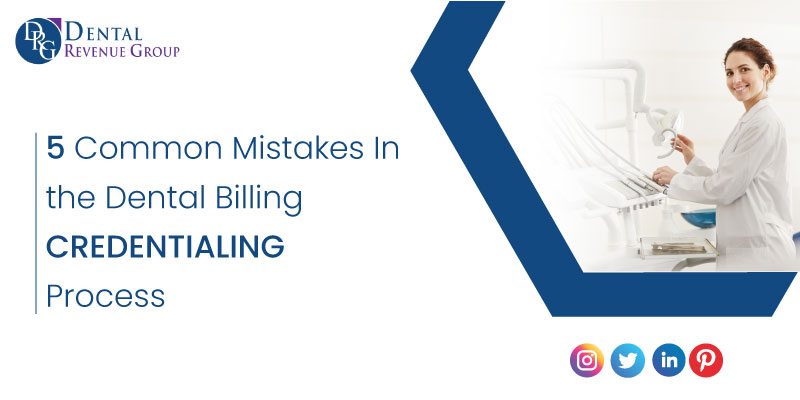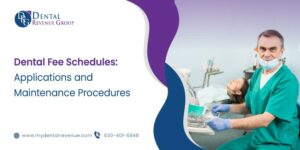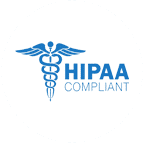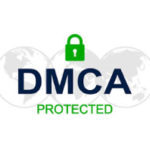Dental billing credentialing is the process by which a dentist enters into an agreement with an insurance company. Acquiring dental billing credentialing in your practice is one of the first things you should do if you decide to accept insurance, whether you are a new practice, a new dentist, or have recently hired a new dentist. This article will teach you the five most common mistakes dental office teams make during the credentialing process, as well as why avoiding these mistakes can save you time, money, and fatigue. As you may know, dental billing credentialing is lengthy, so it’s critical to ensure that you’re taking proper steps to expedite the process.
Mistakes In the Dental Billing Credentialing Process
Following are the top five common mistakes in the dental billing credentialing process.
Applying to numerous dental insurance companies at once
Everybody wants to bring in a lot of business, but getting bogged down with too many applications at once can work against you for various reasons.
Drawbacks:
The two main shortcomings of applying to numerous companies at the same time are given below.
- You might have to settle for a lower fee schedule.
When a dental provider chooses to join an umbrella, they may find themselves in-network with some smaller, lesser-known insurance companies that frequently impose lower fee schedules. Enrolling directly with individual insurance companies may provide a lower fee schedule than an umbrella. You don’t want to be forced to accept low fees that you’ll come to regret later. This is possible if your original plan was to join an umbrella insurance company.
- You will receive more business than your billing system can manage.
Your dental practice will suffer if your schedule is overbooked and your staff is overburdened. Things will start to fall through the cracks, particularly your capacity to collect payments for all of your efforts. This will add errors to the dental billing. Errors are a common cause of insurance claim denials. More mistakes occur when the time-consuming claims procedure consumes more time than your team has available. Observing increased data entry errors, coding errors, and claims submitted without the necessary attachments or evidence is unavoidable when working quickly.
Solution:
Determine what insurance most people have and join with 4 to 5 providers so that you can be available to most people without being swamped with the business you can’t handle.
Incomplete Applications
One of the most common mistakes made by providers during the dental billing credentialing process is submitting incomplete or erroneous applications. Applications are lengthy and thorough, with each question requiring an answer. When providers leave questions unanswered, insurance companies are more likely to consider the application incomplete and return it to begin the process again. It has been observed that many applications have been rejected due to missing data, i.e. checkmark.
Another application dilemma is when the supplier assumes they are all the same. They may believe that the current application is identical to the one they just completed. Unfortunately, that is not the case. Each insurance provider has its application, complete with quirks. Treat each one as a separate document because it is.
Solution:
Fill out the application form completely. Don’t leave a blank even if a question is irrelevant; enter “N/A” rather than skip it.
Too late In the Credentialing Process
The most common mistake we witness among dentists is starting the credentialing process too late. The credentialing procedure can take a minimum of 90 days to complete. The application process should preferably commence before the start date of your new provider.
Drawbacks:
If you are not in-network with major insurance carriers, you may have to turn people away or charge them out of pocket. Furthermore, you may not be reimbursed by insurance because you are not in-network. Neither makes it easy for patients to choose your clinic, so you’re missing out on revenue and growth potential.
Solution:
You should start obtaining an in-network contract as soon as you open your dental office or as soon as you hire a new associate dentist.
Submitting Invalid or Obsolete Supporting Documentation
A standard error with documents is not having the most recent versions available. Of course, organizing and handling the needed documents is a good start, but you should also ensure they are as near the application deadline as possible. Keep in mind that this is a lengthy process. If a document with an expiry date of 60 to 90 days (the credentialing processing period) is supplied, the insurance company may delay the application or classify it as incomplete.
Solution:
Submit updated documents to make the dental billing credentialing process more effective and error-free.
Failure to settle on a fee schedule
A fee schedule is a list of covered services and the particular contracted in-network rates paid by insurance companies to doctors or other providers/suppliers. These costs evaluate the maximum amount that can be invoiced to the patient and the maximum amount that the patient’s plan will pay for covered services.
Every insurance company will not submit to a charge schedule negotiation. Instead of increasing all of your procedures, some insurance carriers will only accept your top 20 CDT codes with your office’s UCR charge schedule. However, knowing which service the insurance provider may be more flexible on the charge seems vital.
Solution:
Accepting the first-rate schedule you come across is a common blunder. Before signing the contract, you can discuss the refund schedule. Don’t be hesitant to request what you want from the insurance company. The worst thing they could say is no. Working with a professional and experienced negotiator can be profitable.
Significance Of Dental Billing Credentialing
By negotiating directly with an insurance company, you will obtain more referrals from the carrier’s subscribers – people with insurance plans that cover themselves and their family members. This is an excellent strategy to acquire access to a larger total patient pool.
Credentialing is one of the most fundamental types of marketing for a dental business. It’s so productive that joining a network is the sole marketing many dentists do for their practice. However, throughout the credentialing process, physicians may see all patients but may be paid out of network or not at all.
The significance of credentialing cannot be emphasized, nor can the requirement for a clear, comprehensive strategy. Avoid these typical blunders and, as always, stick to your best practices, such as starting early and being disciplined throughout the process.
Remember that seeing more patients is one of the cornerstones of boosting business for any dental practice, and a straightforward method to do so is to ensure that your insurance credentialing procedure is in order. It’s quite simple—not the technique, but the results. More credentials translate into more patients, and more patients translate into a more profitable dental office.
Conclusion:
Errors occur! On the other hand, understanding the most common mistakes that dentists make throughout the credentialing process can help you learn from them and prevent them, allowing your practice to get credentialed and generate revenue faster. Insurance companies require loads of information, and it can take up to 90 days to complete the credentialing process. As a result, credentialing can be a time-consuming and labour-intensive procedure for you. Even if you have accurately provided all required documents, dental billing credentialing might take 60-120 days. You can handle the procedure or hire a company to handle the heavy lifting and complete your credentialing. Dental Revenue Group (DRG) is best at handling the dental billing credentialing process. We collaborate with provider relations departments so that you can concentrate on patient care. Our team has years of credentialing experience and can assist you in making the best decisions for your practice and network cooperation.











